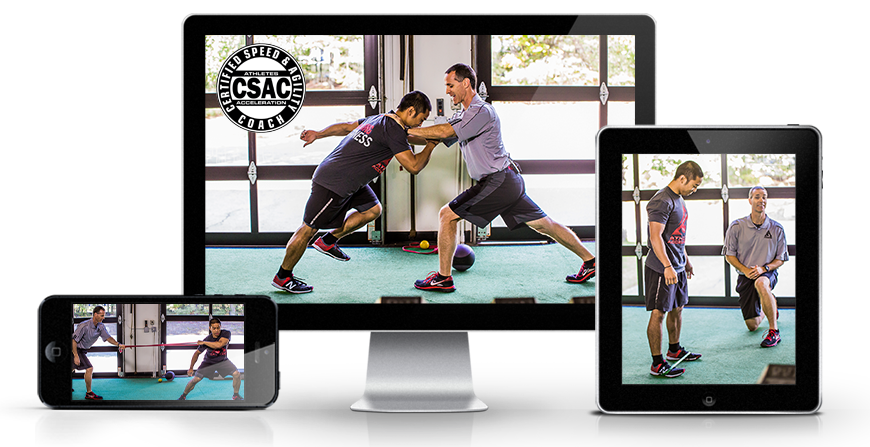First of all, yes – that’s me in the videos and pictures.
And yes, the information that Lee Taft went over was great and informative, and I highly recommend it.
Second of all, I’m already biased towards you starting this certification, because I have already been exposed to this information, and I am also an affiliate for this product – this means I’ll get kickbacks if you sign up using my link.
When Lee and I were going over all of these drills (surprise surprise, I’m not just a model for pictures – we did sprinting and change of direction drills for over 8 plus hours!), I took away many things that I was never exposed to because I didn’t have formal collegiate or professional athletic training.
I understood what it meant to apply force into the ground in a meaningful manner. You can’t do backflips, no handed cartwheels, or do extremely fast footwork from a dancing point of view without applying just the right amount of force to get the move just right!
If you work with athletes, there are tons of ways to get them faster.
- Strength Training
- Physiological Speed & Power
- Joint Positioning
- Technical Practice
In this certification, you’ll be going over WHY you’re choosing which exercise at what exact time for your specific athlete. Not all athletes are the same, and not all athletes respond the same way to any given cue. If you, as a coach or trainer, have a specific desire or wanted outcome that you know will get your athlete or client to the next level, understanding what to say, or what corrective exercise (in the nature shown in this certification) is imperative.
Understanding the Qualities for Speed
Strength training is often touted and praised as one of many ways to improve upon an athlete’s speed. The general recommendation of simply improving an athlete’s speed calls upon understanding the force velocity curve, along with understanding the implications of how strength training can impact an athlete’s overall and absolute speed.
Essentially, just because you can squat heavy, does not mean you can sprint fast. And just because you can sprint fast, does not mean you can squat heavy.

However, somewhere in between these two statements, you will find that it is a general rule of thumb that those with better ability to express strength in squats will also be likely able to sprint at a relatively fast speed.
At some point however, an athlete’s strength in the squat will need to have some type of transfer towards his or her sport. If an athlete cannot display this newfound strength towards either a change of direction or linear sprint mechanic, then I will have to argue that squatting for strength qualities is no longer necessary. Sprinting (or whatever else it may be sports specific skillwise) technique and speed will need to be improved upon in order to get better at sprinting.
From a nervous system point of view, improving elasticity of force production when sprinting is something that can be viewed through several tests. Essentially, force absorption and force production over a duration of time is necessary to understand when you are aiming to improve physiological speed and power.
There are tons of tests to assess an athlete’s reactivity in whichever sporting demands you are aiming to test: 5-10-5 (pro-agility) shuttle, vertical jump (with and without countermovement), or even the amount (and height) of jumps over 10 seconds, are just a few tests you can perform.
Further, whenever a parent of an athlete comes in and says to me “Johnny needs to get a little bit faster,” there are a few things that can be improved upon initially, but the large majority of the time these are 12 to 15 or 16 year old athletes that need a few things:
- Muscular hypertrophy and strength
- Neuromuscular coordination
- Go through an appropriate strength and conditioning program that doesn’t involve only ladder drills and 20 minute runs.
- To go through puberty.
If an athlete is a late bloomer, or hasn’t even gone through puberty, it will be difficult to support a physiological requirement for absolute speed without any hormonal, neuromuscular, or skeletal adaptations that often take months if not years to develop. Asking a baseball player to get a sub 7 second 60 yard dash is difficult to do as a professional, let alone as a freshman high school athlete.
Long story short, improving the physiological make up of an athlete (which is the hormonal, neuromuscular, and skeletal adaptations necessary for athletic development) takes time.
Teaching and Programming for Speed
The next two points are areas where I believe myself and other coaches and trainers can have the fastest lightbulb moments for athletes, simply because this is the area where changes can be seen relatively fast. Improving strength and physiological power and speed take time. Telling an athlete to get lower out of a two point stance in order to improve push off out of the hole is like magic.
When speaking about joint positioning, it is imperative to understand that there are good and bad positions when thinking about improving your sport specific demand.
There is a difference between knee valgus, and hip internal rotation in the effort to absorb force when decelerating or changing directions.
There is a difference between dorsiflexion of the ankle over the talocrural joint and plantarflexion of only the metatarsals of the foot.
Improving someone’s requisite range of motion and control over that range of motion can take several forms and methods in order to achieve said position. However, just achieving that end position is not the only purpose for training – it is these movements backed by strength, power, speed, and endurance qualities that is the end goal!
If you want to improve an athlete’s speed, getting them into the right positions from a general perspective (ie. Can you move your ankle into dorsiflexion in order to deliver an appropriate force into the ground during sprints?).
Talking About Practice?
Now the idea of practice can take several forms. The essential goal of practicing for speed is to learn a sequencing of events in order to facilitate your body in the face of an opponent or external and moving object. If you can accelerate and speed past an opponent on the soccer field, or if you can run a ball into the end zone faster than anyone else can catch you – then you can and should work on that skillset.
This certification won’t go over the technical aspects of how to get your athletes better through specific drills, like running slant drills, or working on technical cone drills for teams – but the ideas remain for individual athletes. You can learn what external cues to use to facilitate better movement quality, along with understanding how to improve upon your athletes’ errors that may occur.
Certified Speed and Agility Coach
I like the things that Lee Taft has taught me and allowed me to see. These are things that I now use on a daily basis with many of my athletes, as the athletes that come through at Cressey Sports Performance are not just baseball athletes, but often multi-sport athletes who are looking to improve overall awareness of their movement capacity. Please check out his Certified Speed and Agility Certification if you are anyone who trains with youth, collegiate, or professional athletes.
As always,
Keep it funky.






